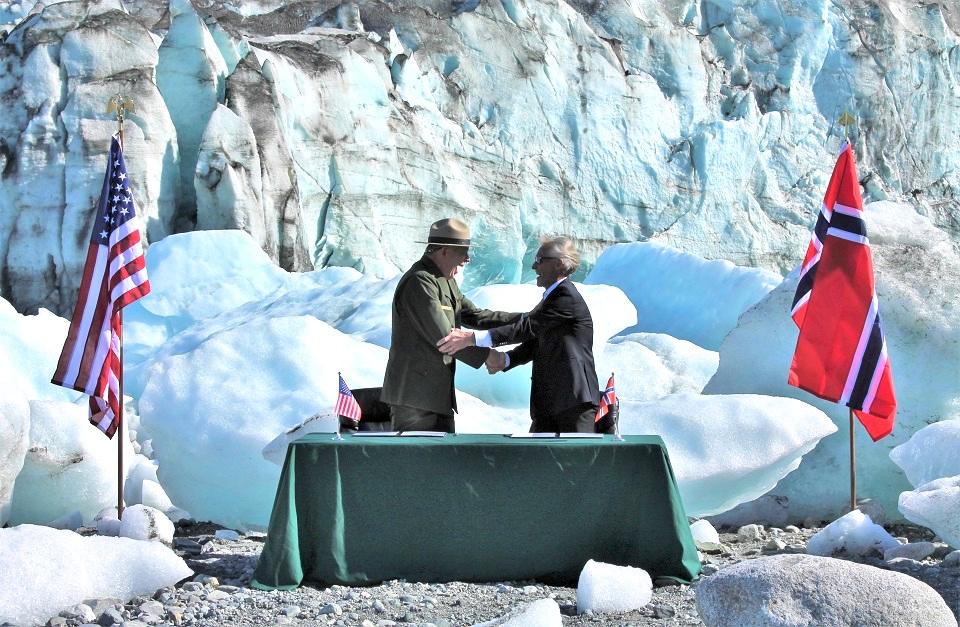
Superintendent Hooge and West Norwegian Fjords Board Chairman Arne Sandes shake hands after signing the agreement in front of the Lamplugh Glacier in Glacier Bay/NPS, S. Schaller
Against a backdrop of ice blocks and the Lamplugh Glacier, representatives from Glacier Bay National Park and Preserve and West Norwegian Fjords World Heritage Site signed a sister park agreement. The agreement acknowledges the similarities between the two protected areas and promotes the sharing of ideas and best practices between site managers.
“This provides an incredible opportunity for protected areas that share so much to learn from each other,” said Glacier Bay Superintendent Philip Hooge, one of the signatories.
Management Board Chairman Arne Sandnes signed on behalf of the West Norwegian Fjords, with representatives from both sites looking on.
The signing event occurred during the recent United Nations Educational, Scientific, and Cultural Organization World Heritage Site Marine Managers Conference held in Glacier Bay. This was the fourth of such gatherings for managers of marine protected areas around the world to discuss challenges and share best practices on topics such as marine debris, tourism, working with indigenous populations, and adapting to climate change.
The seeds for the sister park agreement were sown at a previous meeting nearly nine years ago in Hawaii when representatives from Glacier Bay and the West Norwegian Fjords both presented descriptions of their sites and immediately recognized the similarities in issues and challenges faced by managers.
“Talking with the Norwegians it quickly became clear that both sites would benefit from sharing lessons learned, and continuing the dialogue regarding ongoing and emerging issues,” said Hooge.
Both protected areas feature scenic fjords that are popular destinations on cruise ship itineraries. Site managers at both locations also seek to work closely with local communities, including people with connections to the landscape that go back many generations.
Since those initial conversations in Hawaii site representatives have shared management plans, research and monitoring protocols, and met several times to discuss challenges related to cruise tourism, environmental protocols, and interpretation and education programs. With the signing of the agreement managers anticipate those conversations will continue in the spirit of preserving the outstanding features and values of both places into the future. The agreement itself does not infringe on the sovereignty of either nation to manage its protected area.
In addition to being designated as a national park and preserve, Glacier Bay is part of a 24.3-million-acre international world heritage site that includes Wrangell-St. Elias National Park and Preserve in the United States as well as the Tatshenshini-Alsek Provincial Park and Kluane National Park and Reserve in Canada. Glacier Bay is also the ancestral homeland to the Huna Tlingit. West Norwegian Fjords World Heritage Site is largely comprised of two fjords with steep walls, spectacular waterfalls and a landscape dotted with many active small farms, as well as ancient roads and archeological sites dating back to the Middle Ages.



Add comment